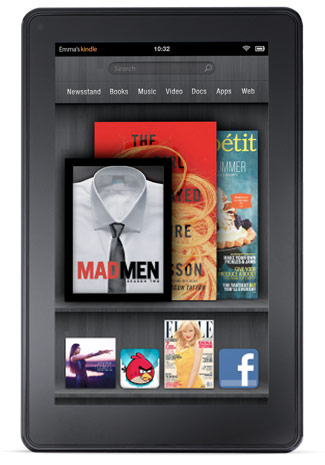The oft-rumored and long-awaited Kindle Fire 7” Android-powered tablet was revealed today at Amazon’s press and media event and will retail for $199. With the Kindle Fire, Amazon has done what Samsung, Motorola, RIM, HP and so many others have failed to do. They’ve created the first truly successful non-iPad tablet…and it hasn’t even hit the market yet.
Let’s face it. Tablets that aren’t named “iPad” aren’t doing so hot in the marketplace. Apple’s marketing and presence are simply too strong for any other tablet maker to truly compete. That’s not to say that other tablets aren’t worth it, it’s just that they’re…other tablets. When the average consumer walks into a store with $500 to spend on a tablet, odds are, they’re leaving with an iPad. Why? Not because the iPad is inherently better than the current crop of Android tablets but because Apple has an enviable mindshare. I’d wager that many consumers simply don’t know other tablets exist or simply don’t care because those others aren’t an iPad.
Amazon has what other tablet-makers lack. They have a reputable and established brand name in the Kindle and (this is important) a massive customer base to sell to. People know Kindle, they respect Kindle. In the same way Apple established themselves long before the release of the iPhone, which catapulted them into the spotlight as the unquestioned leader of the smartphone market and, in many ways, the tech world as a whole. The iPad was an easy sell.
Now, Amazon is in position to corner the market on tablets with a portable, usable and, perhaps most importantly, inexpensive tablet. One of the biggest reasons why non-iPad tablets haven’t taken off is that their manufacturers haven’t been willing to fight Apple on price. The closest was ASUS with its $399 16GB Transformer but even then, that wasn’t enough.
Amazon is doing that. Take the Touchpad for example. When HP decided to halt the production of its WebOS hardware, they sold off their stock for an unprecedented $99 and $149, creating an equally unprecedented response. Consumers flocked to brick-and-mortar retailers and the internet en masse to grab one of the cheap tablets. Consider this. The hardware has just been discontinued and support for WebOS is up in the air. There is no guarantee that HP will service these things for the foreseeable future and no guarantee that developers will support it with development and people still bought them hand over fist. While many shoppers bought them for the sake of turning a profit on eBay, many more bought them because they wanted a tablet. No one cared that the iPad has 100,000 apps in its App Store. No one cared that the iPad is thinner, lighter and more powerful. What they did care about is the fact that the HP Touchpad was the cheapest tablet on the market and is still capable of performing most day-to-day tasks.
Cheap tablets sell. Amazon realizes this, and what is the $199 Kindle Fire in today’s tablet market with $499 iPad 2s, Galaxy Tab 10.1s and Xooms? Cheap. The Barnes and Noble Nook Color, which retails for $249, is probably the best selling Android tablet out there at more than 3 million units sold. Why? It’s cheap. Considering how well known Amazon’s name is in the tech world, the Kindle Fire should have no trouble besting those numbers.
Now, let me finally address the big question I’ve been dancing around this whole time. Is the Kindle Fire the first real threat to the iPad? Yes and no. Yes in that it’s the first tablet I think has a legitimate chance to stand up to Apple’s seemingly unstoppable juggernaut. No in that, like I said, the iPad is a seemingly unstoppable juggernaut. Apple’s hype train is moving far too fast to be derailed now by Amazon’s upstart. Could it happen? Sure, lightning could strike twice, as it did for Apple and this thing could take off like a rocket.
Amazon has a chance here to leverage their name to help make tablets acceptable to the mainstream because, despite the iPad’s success, the tablet market is still a niche. With the proper marketing, a potentially great $199 tablet can change that. I am highly intrigued by the possibilities of the Kindle Fire. It looks like a nicely capable (TI OMAP 1GHz Dual Core CPU, 8GB storage, 512MB of RAM) and user-friendly piece of tech that I’d love to play around with. I hope manufacturers will start following Amazon’s example here and make their tablets more affordable (Apple excluded since they aren’t known for lowering prices and I don’t expect them to start now) and I look forward to seeing what Amazon has in store, perhaps a 10.1” tablet…maybe.
We’ll see just how well the Kindle Fire does when it hits the market on November 15th but I think Amazon has what it takes to set the market ablaze.
 The Mind of Game
The Mind of Game
